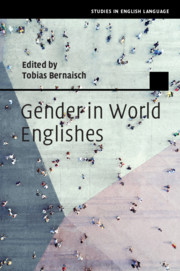Book contents
- Gender in World Englishes
- Studies in English Language
- Gender in World Englishes
- Copyright page
- Dedication
- Contents
- Figures
- Tables
- Contributors
- Chapter 1 Introduction
- Chapter 2 Localisation, Globalisation and Gender in Discourse-Pragmatic Variation in Ghanaian English
- Chapter 3 Sociolinguistic Variation in Intensifier Usage in Indian and British English
- Chapter 4 Tag Questions and Gender in Indian English
- Chapter 5 Hedges and Gender in the Inner and Expanding Circle
- Chapter 6 The Role of Gender in Postcolonial Syntactic Choice-Making
- Chapter 7 Social Constraints on Syntactic Variation
- Chapter 8 Linguistic Colloquialisation, Democratisation and Gender in Asian Englishes
- Chapter 9 Gender, Writing and Editing in South African Englishes
- Index
- References
Chapter 4 - Tag Questions and Gender in Indian English
Published online by Cambridge University Press: 11 December 2020
- Gender in World Englishes
- Studies in English Language
- Gender in World Englishes
- Copyright page
- Dedication
- Contents
- Figures
- Tables
- Contributors
- Chapter 1 Introduction
- Chapter 2 Localisation, Globalisation and Gender in Discourse-Pragmatic Variation in Ghanaian English
- Chapter 3 Sociolinguistic Variation in Intensifier Usage in Indian and British English
- Chapter 4 Tag Questions and Gender in Indian English
- Chapter 5 Hedges and Gender in the Inner and Expanding Circle
- Chapter 6 The Role of Gender in Postcolonial Syntactic Choice-Making
- Chapter 7 Social Constraints on Syntactic Variation
- Chapter 8 Linguistic Colloquialisation, Democratisation and Gender in Asian Englishes
- Chapter 9 Gender, Writing and Editing in South African Englishes
- Index
- References
Summary
This paper is concerned with one of the features typically associated with genderlectal differentiation in language, namely tag questions. It investigates the repertoire of tag questions in Indian English, comprising both canonical and non-canonical tags such as invariant isn’t it and the indigenous forms no/na. Both a quantitative and a qualitative approach are chosen. Firstly, we apply a multifactorial analysis to the data derived from the private dialogues in the International Corpus of English for India (ICE-India) in order to determine the interplay of (sociolinguistic) context factors for the occurrence of specific tag question types. Secondly, we consider patterns of social interaction and their linguistic correlates in all-female, all-male, and mixed-group conversations, thus trying to establish locally meaningful uses of tags. We also offer some general considerations on the feasibility of integrating more recent sociolinguistic approaches towards the category of gender in corpus-linguistic research.
Keywords
- Type
- Chapter
- Information
- Gender in World Englishes , pp. 69 - 93Publisher: Cambridge University PressPrint publication year: 2021



